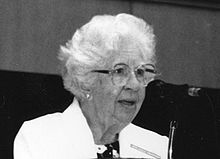Eleanor J. Gibson | |
|---|---|
 Eleanor Gibson - Keynote Address - 1993 APS Convention | |
| Born | Eleanor Jack December 7, 1910 |
| Died | December 30, 2002 (aged 92) |
| Citizenship | American |
| Alma mater | Smith College (B.A., 1931) (M.S., 1933) Yale University (Ph.D., 1938) |
| Known for | Visual cliff, perceptual learning, differentiation theory, enrichment of embedded structures |
| Spouse | James J. Gibson |
| Children | James J. Gibson Junior Jean Gibson |
| Awards | National Medal of Science (1992) APA Award for Distinguished Scientific Contributions to Psychology (1968) The American Psychological Foundation Gold Medal Award for Life Achievement in Science (1986) |
| Scientific career | |
| Fields | Psychology, developmental psychology, comparative psychology, experimental psychology, ecological psychology |
| Doctoral advisor | Clark L. Hull |
Eleanor Jack Gibson (7 December 1910 – 30 December 2002) was an American psychologist who focused on reading development and perceptual learning in infants. Gibson began her career at Smith College as an instructor in 1932, publishing her first works on research conducted as an undergraduate student. Gibson was able to circumvent the many obstacles she faced due to the Great Depression and gender discrimination, by finding research opportunities that she could meld with her own interests. Gibson, with her husband James J. Gibson, created the Gibsonian ecological theory of development, which emphasized how important perception was because it allows humans to adapt to their environments. Perhaps her most well-known contribution to psychology was the "visual cliff," which studied depth perception in both human and animal species, leading to a new understanding of perceptual development in infants. Gibson was elected to the National Academy of Sciences in 1971, the National Academy of Education in 1972, and to the American Academy of Arts and Sciences in 1977. In 1992, she was awarded the National Medal of Science.